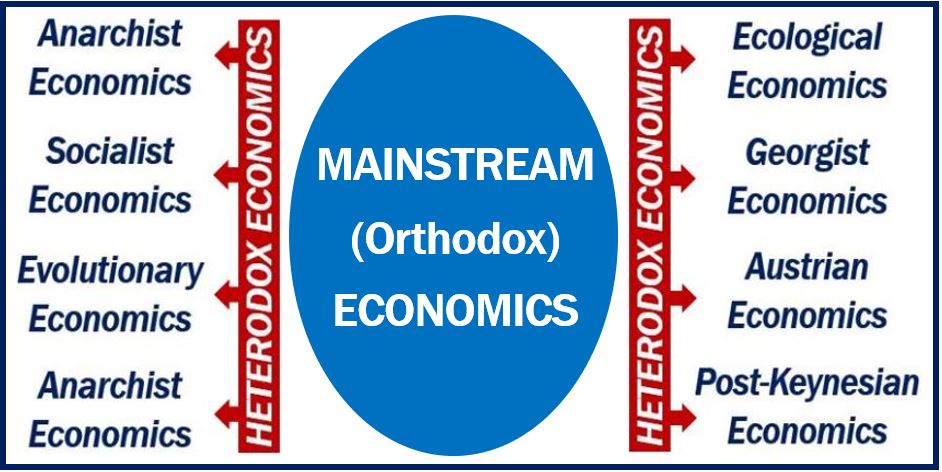 Mainstream economics is orthodox economics. In other words, schools of economic thought that we consider to be orthodox. The word mainstream refers to activities, ideas, or attitudes that most of us regard as conventional or normal.
Mainstream economics is orthodox economics. In other words, schools of economic thought that we consider to be orthodox. The word mainstream refers to activities, ideas, or attitudes that most of us regard as conventional or normal.
The body of knowledge, models, and theories of economics, as taught across colleges, that economists generally accept as a basis for discussion, we refer to as mainstream economics.
Mbaskool.com has the following definition of the term:
“Mainstream economics deals with the financial markets, functioning of governments, and demand and supply of goods and services.”
“It is also known as orthodox school of economics as opposed to the heterodox economics which includes the very different approaches like Marxist and socialist.Mainstream Economics is a most commonly used form of economics. This form of economics is taught in many universities under different forms and names.”
Hetorodox versus mainstream economics
The term contrasts with heterodox economics or heterodoxy. The word heterodox means not conforming with accepted beliefs and standards, i.e., not orthodox. Heterodox is the opposite of mainstream.
Economists say that heterodoxy comprises economic thoughts, theories, and beliefs that go beyond neoclassical economics. Neoclassical economics is a school of economics that believes that the consumer is the ultimate driver of price and demand.
Hetorodox economics includes Marxian, socialist, anarchist, Georgist, feminist, and Austrian economics. It also includes post-Keynesian, evolutionary, and institutional economics.
According to Wikipedia:
“Mainstream economics deals with the ‘rationality–individualism–equilibrium nexus’ and heterodox economics is more ‘radical’ in dealing with the ‘institutions–history–social structure nexus.'”
“Many economists dismiss heterodox economics as ‘fringe’ and ‘irrelevant,’ with little or no influence on the vast majority of academic mainstream economists in the English-speaking world.”
Assumptions, methods, and topics
Mainstream economics differs from other schools of economics by its assumptions, methods, and topics.
Assumptions
Several assumptions, which heterodox schools reject, underpin mainstream economic models. Rational choice theory, for example, a neoclassical assumption, is one example. Rational expectations and a representative agent, which are also neoclassical assumptions, are other examples.
The individual is the starting point of orthodox economic analysis. Mainstream economists define people as units with a common goal, i.e., maximization through rational behavior.
Methods
Mainstream economics is work that mainstream economists are willing to engage. It requires conforming to mathematical models which feature optimization, comparative statics, and calculus.
Areas of thought, under this definition, which we typically think of as heterodox because they clash with typical neoclassical assumptions, are considered mainstream when they are engaged in the mainstream. In other words, when we use mainstream methods.
Some economic fields, such as Austrian economics, include both heterodox and mainstream economics. Neuroeconomics, institutional economics, and non-linear complexity theory also include both mainstream and heterodox economics.
Topics
Mainstream economics includes private and public goods as well as theories of market and government failure. Mainstream economists have a range of views on how desirable or undesirable government intervention is.
